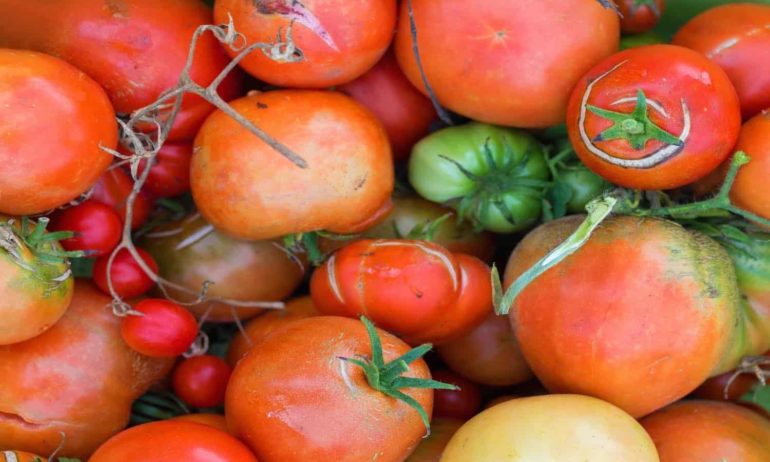While almost 1 billion people suffer from malnutrition worldwide, consumers in high-income countries discard up to 30 percent of fruit and vegetable purchases in their homes. Hungry Harvest fights food waste by connecting customers with surplus, pre-retail fruits and vegetables that would otherwise go to landfills. For each bag delivered, the company also donates a healthy meal to someone in need.
Food Tank checked in with CEO and Co-Founder, Evan Lutz, to learn more about how Hungry Harvest is working to reduce food waste and create a stronger community of healthy, nourished eaters.
Food Tank (FT): What have been the biggest challenges both for you personally and for your company overall since 2013? What have been the most valuable lessons learned in this time?
Evan Lutz (EL): For Hungry Harvest, our two biggest challenges have been market education and logistics. Our team was very inexperienced at logistics, yet we deliver over 600 bags of produce to as many places each week. It was difficult to set up an efficient system for deliveries, and we’re still tweaking it, but it remains one of our biggest challenges as we expand. The second challenge for Hungry Harvest is market education. Consumers simply don’t realize that surplus produce is fine to eat and poses no health risks. It’s all perfectly fresh, and an absurd amount of produce goes to waste every year. As the topic of ugly fruit and vegetables and food waste becomes a trending issue, we expect this challenge to become easier to overcome.
Personally, my biggest challenge is managing the many moving pieces that are essential to this business. It’s my dream to be a social entrepreneur and living this dream does not come without caveats such as many sleepless nights, stressful days, and failures. I’ve learned more in the past two years than most people learn in 20 years of education. This experience has fostered my growth as a better leader, public speaker, motivator, delegator, manager, mentor, executor, and worker.
FT: How does Hungry Harvest select new partners? In general, do you approach them or do they approach you? Are there certain criteria for inclusion in the program?
EL: We connect with any and all farms and wholesalers that we can. One wholesaler recently had 5,000 pounds of surplus produce and we could only use a portion of it, so we donated the rest. There is an unfathomable amount of food waste occurring all around us, and yet finding it has been tricky. As our brand and mission gains traction, it’s becoming easier to find suppliers who “get it” and want to participate.
Our only criteria are that produce has to be quality and pre-retail. We don’t touch anything that has every seen the inside of a restaurant, grocery store, or another form of retail outlet. And of course, customer experience is our number one priority.
FT: Could you share a little bit about the groups that forms your customer base? How do you engage with these different individuals? Are most people already familiar with the Community Supported Agriculture (CSA) model?
EL: We have two main target customer bases: Millennials (age 22-29) in urban areas and mothers or families (age 35-50) in suburban areas. Most of our customers have never tried a CSA. The CSA model is a great concept and improved upon it. Instead of paying US$400 to $600 up front, we allow people to pay weekly to make it easier on their budget. And instead of making the customers drive to pick up their produce, we deliver straight to their door, free of charge.
We engage with customers through mainly digital mediums such as email, social media, and our website. We do, however, also host events throughout the community, such as Free Farmers’ Markets, where give away anywhere from five to 10,000 pounds of produce to anyone that wants to come. Our model is simple: for every bag delivered, we donate a healthy meal to someone in need. We’re passionate about making sure people can eat healthfully because a healthy person is an empowered person. An empowered person can make a difference. A lot of empowered people can change the world.
FT: We live in a world where millions of people are undernourished, yet resources are wasted all along the supply chain. What steps can each of us take today to help create a more sustainable and just food system? Can we change consumer standards to make “ugly food” the norm?
EL: Here is a simple message to every consumer: follow your taste buds, not your eyes. It’s a misnomer that food has to look perfect to taste perfect. Food companies promote aesthetically pleasing food items, and consumers respond by only buying the perfect looking items. There is an absurd amount of waste on the back-end of the food system hidden from the average consumer. The topic of food waste is increasingly becoming mainstream and so this enormous issue, once hidden to the average consumer, is finally being brought to light.
FT: Do you have plans to expand beyond Baltimore and Washington, D.C.? Is providing more access to organic produce part of your vision? Where do you see Hungry Harvest in 5 years?
EL: We are currently planning expansion to two more major markets outside of the Washington D.C. metro area and started offering Organic Harvests at the beginning of August. In five years, we aim to be the largest direct-to-home produce delivery service in the country. Our mission is to build healthier communities through selling produce with purpose. Consumers are increasingly looking for brands that aren’t just good for them, but also help the environment and their local community. We wish to set a precedent of how for-profit companies should operate: by giving back and doing the right thing.













